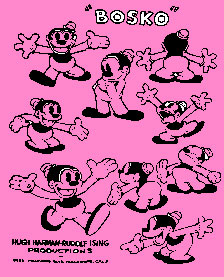 When I was a preschooler I saw some Bosko cartoons, as vintage cartoons were shown daily on something called Cartoon Carnival or something similar. He really stuck in my memory, but I was well into adulthood before I realized he was supposed to be an African American chap.
When I was a preschooler I saw some Bosko cartoons, as vintage cartoons were shown daily on something called Cartoon Carnival or something similar. He really stuck in my memory, but I was well into adulthood before I realized he was supposed to be an African American chap.
I thought he was either the same as Betty Boop's human-like dog friend, as Bosko kind of got mixed up in my tot's brain with Bimbo.
But then I "realized," or thought I had realized, he was actually a bear, because there were many television ads for Bosco chocolate syrup with Bosco Bear as the animated spokes-being. In fact, Bimbo was probably a bear, too. They were all the same guy.
Bosko's cartoons draw him as a pretty regular human. Still, if you took the ears off Foxy Fox, Mickey Mouse, Cubby Bear, or Oswald Rabbit, you'd have pretty much the same character design, all of whom were drawn largely as a black figures with white eyes & mouths & four fingers.
And if the animal-people of other cartoons can be so black without implying a blackface minstrel show negroes, it's small wonder I failed as a four year old to realize Bosko was a rather typical of his day (long before my day) blackface figure in a Bill "Bojangles" Robinson bowler hat.
>
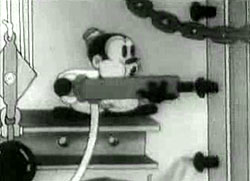 Hold Anything (1930) was the third Bokco cartoon, built around the song "Don't Hold Everything" by Ray Henderson, Lew Brown & B. G. de Sylva. Hold Anything (1930) was the third Bokco cartoon, built around the song "Don't Hold Everything" by Ray Henderson, Lew Brown & B. G. de Sylva.
The song was one of several from the 1928 Broadway hit jazz musical Hold Everything which launched the career of Bert Lahr, later to become immortalized playing the Cowardly Lion in Wizard of Oz.
Bosko & a bunch of hod-carrying mice are doing high construction on a skyscraper, dancing all the while to the snazzy marching tune.
When one of the mice falls on a saw, the saw makes a pleasant sound, so Bosko grabs the saw & makes sweet music while the mouse bounces on the musical saw & gets its head sawed off, then fits itself back together & falls from the skyscraper into the belly of a yawning billygoat, leaving the goat by its stomach-door.
Bosko sees a pretty secretary through the window of the building next door & flirts with her, dancing back & forth on an unsteady gerter.
This is Bosko's female counterpart Honey. Bosko climbs in her office window & plays the typewriter as a piano, while she dances & scat-sings along the ledge.
That Bosko likes jazz is just about the onluy concession to him being African American; he's otherwise just a guy, a fact that might be regarded as somewhat progressive for 1930, when most such characters were portrayed as shiftless or scared of ghosts. Bosko by contrast is almost always a skilled laborer.
Surreal gags continue nonstop, gags wtih the goat being stand-outs. After nearly six minutes worth of sight gags, Bosko falls to the ground & breaks into a lot of little Boskos.
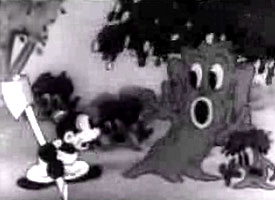 The Tree's Knees (1931) opens with Bosko carrying an axe into the woods to chop down a tree. The title is a play off the Roaring Twenties jazz slang for something really pleasant which woudl be "the bee's knees." The Tree's Knees (1931) opens with Bosko carrying an axe into the woods to chop down a tree. The title is a play off the Roaring Twenties jazz slang for something really pleasant which woudl be "the bee's knees."
Bosko's whistling the Joseph Burke number "Dancing with Tears in My Eyes." He arrives at the base of a tree, which has a baby tree beside it.
As Bosko prepares to chop the big tree down, it & its offspring open their eyes & look frightened. A squirrel springs out of the big tree's mouth & exclaims, "Oh woodman, spare that tree!"
Several bushes or baby trees gather around the parent tree's trunk (or "knees"). So goodhearted agreeable Bosko plays the tree a number on the harmonica & plays "Here We Go Round the Mulberry Bush" as the shrubs dance about the tree like a maypole. Bosko's first spoken line is his occasional catch phrase, said of the baby-like shrubs, "Aint that cute!"
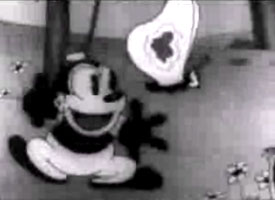 One of the shrubs gives him the rasberry which for some reason makes Bosko mad. He chases after the shrub or baby tree that has turned its roots into feet. One of the shrubs gives him the rasberry which for some reason makes Bosko mad. He chases after the shrub or baby tree that has turned its roots into feet.
Bosko accidentally rips off its bark like it was a body-sock & the baby tree bursts into tears, as well it might since it would die without its bark. It shivers & Bosko gives it its bark to put back on, & the little guy thanks Bosko by kicking him in the shins.
Our woodsman takes up hix axe anew & whistles his way through the forest looking for a less animated tree. The next tree he fixes on, though, can't be cut down because it has a bird's nest coddled in its "arms" or branches, while the mommy bird squawks "Rock-a-Bye Baby in the Tree Top." Once again Bosko says "Ain't that cute!" but then gets a plop of bird poop on his bowler hat. He looks up at a branch & it was bird poop after all, but a trousered blackbird's chewing tobacco.
Abandoning the axe, Bosko chases happily after a butterfly. The butterfly leads him to a lovely waterfall where a row of birch saplings can be played like a harp. Bosko plays Oscar Rasbach's "Trees" while a nearby tree rigs up a violin to play along, & a weeping willow moved by the music weeps beside the pool.
Some pussywillows go "meow, meow," in time to the tune. Mice use a long saw as a teeter-totter, getting music out of it. One of the mice bounces off the saw into the water & nearly drowns, squeeking, "Help! Help!" & is saved bit its companion. A rush of additional gags bring it all to a close, with Bosko's ending shout of "Hot dog!"
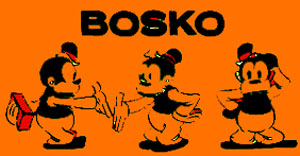 It's hard to tell sometimes if the Bosko character is supposed to be a negro boy or a grown man. In the main he seems to be a small boy, but with jobs & dating privileges of a grown-up. It's hard to tell sometimes if the Bosko character is supposed to be a negro boy or a grown man. In the main he seems to be a small boy, but with jobs & dating privileges of a grown-up.
In later cartoons of his Technicolor career, his character would be completely redesigned as "Li'l Old Bosko" & definitively a small boy with a small boy's interests & attitudes. But initially he was rather ambiguous as to age.
As blackface characters go, he's really more like Mickey Mouse without the mouse ears. Mickey is simultaneously a child & a grown-up, as was dog-person Bimbo in the Bimbo & Koko cartoons, & as was Foxy in the Foxy cartoons.
Though designed as a blackface character akin to minstrel show & vaudeville comedians (both caucasion & negro comedians & singers performed in blackface), Bosko's library of gags have nothing to do with the blackface repertoire of stereoptypes, & much more to do with the repertoire of Foxy, Bimbo, Oswald, or Mickey.
The racially stereotyped behaviors of blackface negro figures in cartoons & in live-action cinema largely bypassed Bosko since despite being more fully human than Bimbo, Foxy, & Mickey, he really was of their character-type.
So when Bosko goes to Africa (where he meets only animals & not native people), for once we have a black man in Africa who doesn't need to be naked with bone through nose or hair.
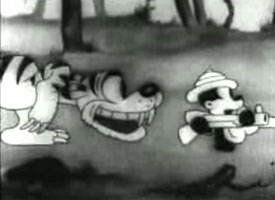 In Congo Jazz (1930), Bosko in pith helmet & with rifle gets to play the character-role who'd ordinarily be categorized the Great White Hunter stalking wildlife in Africa. Could this be the one & only time in vintage cinema, animated or live-action, that the Great White Hunter was a black man? In Congo Jazz (1930), Bosko in pith helmet & with rifle gets to play the character-role who'd ordinarily be categorized the Great White Hunter stalking wildlife in Africa. Could this be the one & only time in vintage cinema, animated or live-action, that the Great White Hunter was a black man?
Bosko is sneaking through the jungle, periodically terrified. A tiger is soon tracking him. He tries to shoot the Asian tiger (which we'll pretend actually might've lived in Africa) but a small round bullet just falls out of the end of his shotgun, or perhaps musket, which encourages the well-pleased tiger to try to eat Bosko.
Early sound cartoons were often more about the music than the dialogue, so there are "music" gags throughout: Bosko yelling in terror in time to the music; Bosko playing a whistle & singing "la la la" to appease the tiger; Bosko playing the tiger's whisker's like a harp; playing the tiger's tail like a washtub bass.
Before his jungle adventures are over we will get snippets of "Battle Hymn of the Republic" & "Here We Go Round the Mulberry Bush."
The tiger is just about tamed by the music. But just as the tiger is getting friendly & dancing about to Bosko's music, Bosko betrays the happy dancing creature by kicking him over a cliff, which seemed not very nice at all. We never see the tiger again, & just when we were beginning to like him.
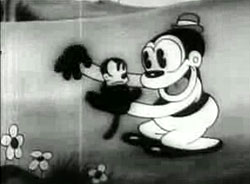 Bosko next encounters two baby monkeys playing leapfrog. Bosko speaks his first piece of dialogue: "Hello!" as he picks up one of the baby monkeys, which scowls without appreciation for being grabbed. Bosko next encounters two baby monkeys playing leapfrog. Bosko speaks his first piece of dialogue: "Hello!" as he picks up one of the baby monkeys, which scowls without appreciation for being grabbed.
When Bosko's dissatisfied with the tiny monkey's behavior, he takes it upon himself to give the little guy a spanking. About then a big father ape comes up behind Bosko, not pleased he's beating up the child. Note that while the small monkeys were indeed monkeys with tails, the father is a different species, a great ape without tail.
To save himself a bruising, Bosko offers the ape a stick of gum, with the second moment of dialogue: "Will you have a stick of gum Mr. Ape?" This results in a bonding experience between man & ape. They pull out lengths of gum to play together like mouth-harps while the baby monkeys dance.
Ostritch, kangaroo, & other "African" animals whether African or not dance about as well. Bosko strikes up a bit of "barnyard jazz" & all the animals take up the beat & play together.
This is Bosko's main song for the episode, the Joseph Berke composition "When the Little Red Roses Get the Blues for You" which was a hit for Al Jolsen (one of the last blackface performers) the very year it was used in this cartoon.
Bosko conducts the jungle orchestra with plenty of sight gags. In addition to animals dancing & playing instruments, we also see a palm tree dancing. An elephant's trunk becomes a slide trumbone; & so on from gag to gag until Bosko is laughing with the hyenas for the fun of it all. The poor betrayed tiger never came back, though.
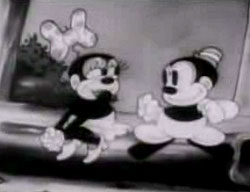 Honey is teaching her kitten Wilber to play violin, getting more & more frustrated with Wilbur's lack of talent. She calls Bosko at his house, but he's in bed. His dog Bruno tries to get him to answer the phone, & considerable difficulties progress as Bruno has to literally drag him & all the covers out of bed.
Honey is teaching her kitten Wilber to play violin, getting more & more frustrated with Wilbur's lack of talent. She calls Bosko at his house, but he's in bed. His dog Bruno tries to get him to answer the phone, & considerable difficulties progress as Bruno has to literally drag him & all the covers out of bed.
So begins Bosko & Honey; aka, Bosko's Dizzy Date (1932). Honey returns to teaching Wilbur while waiting for Bosko to come over. Bosko brings his sax, playing jazz in her front yard.
Honey stands on a balcony edge singing with delight. It's the same song she was trying to teach Wilber, "Put the Sun Back in the Sky" composed by Joseph Meyer. Inside, Wilber jealously squalls & starts some mischief.
Bosko goes bike riding with Honey on his handlebars, with some harrowing moments. Bruno brings a picnic basket, though he gets sidetracked by the wildlife.
They get caught out in a rain & thunderstorm, taking refuge by a building as Bosko sings "It ain't gonna rain no more" until water bursts from a drainpipe & soaks him. Honey says, "Tee hee! You're all wet, Bosko!"
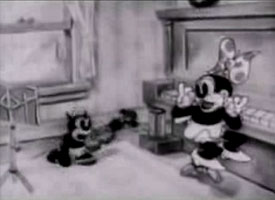 The gags are random & we get even less of a story than usual, not that plots were ever significant in Bosko films. The gags are random & we get even less of a story than usual, not that plots were ever significant in Bosko films.
Usually he has a significant job or skill to express, but this time he's shown to stay in bed all day & doesn't want to answer the phone or do anything. It's hard to say whether this near-brush with a stereotypical behavior was accidental & could've been imposed on any character, or if for once the animators were thinking of Bosko in terms of the Stepin Fetchit style of shiftless negro.
And it's certainly intentional that Honey's big bow resembles the bone-through-the-hair seen in many demeaning animated figures of African peoples. Still, given how racistly agregious so many animated "darkies" were in other cartoons, it remains that Bosko & Honey are well-treated & comparatively well-rounded figures who have varied interests & abilities & get into scrapes because they're fully involved in their world in positive ways.
And whatever failings the whole series of Bosko cartoons may manifest from time to time, in the main, it's impressive that the animators rarely relied on the sorts of insulting stuff that bleed through with most black characters in early animation.
Dialogue is generally minimal in Bosko cartoons. For what there is, Honey's voice is provided as usual by Rochelle Hudson, who continued to voice Honey later in the '30s when Bosko & Honey became more obviously "children" & a tad more pickaninny-stereotyped. Rochelle was an actress of some significance, having played Natalie Wood's mom in Rebel Without a Cause (1955), & Cosette in Les Miserables (1935), besides a great many roles in minor films throughout that era.
Bosko's voice from first to last film was provided by Carmen "Max" Maxwell, one of the Harman/Ising animators who had formerly worked for Walt Disney. He falsettoed the voice in order to partially override Bosko's adult jobs & interests & make him more of a kid. But the first time he did Bosko's voice, in Bosko the Talk-Ink Kid (1929), he gave him a minstrel show "darkie" accent, though afterward the phony dialect was jettisoned.
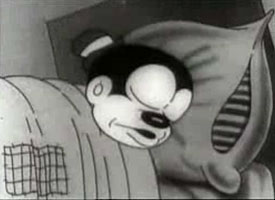 "I Can't Give You Anythign But Love" is playing on the soundtrack of Bosko's Holiday (1931).
"I Can't Give You Anythign But Love" is playing on the soundtrack of Bosko's Holiday (1931).
The phone is hopping & ringing, but Bosko under his patched blanket is hard to wake up. Even his alarm clock is sleeping, but the phone finally gets its attention. THe clock runs over to Bosko's bed trying to wake him, while the phone gets increasingly frantic.
Eventually sleepy Bosko gets to the phone. It's Honey, whose voice makes him alert. She invites him on a picnic. Much of this story, up to this moment, was repeated Bosko & Honey, but it's on the verge of getting a mite more imaginative.
Bosko whistles for his car, which comes out of the garage. He gives the engine a good winding, & they're off. The car's three puppies (toy trucks) try to follow & Bosko tells them "Go home!"
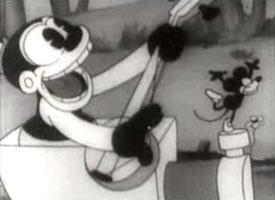 He plays his banjo as the car drives along the road. A mouse is pretending to be the hood ornament. When Bosko needs a new string for his banjo, he clips off the mouse's tail. The angry mouse is able to pull his tail to stretch it to its former length, but when Bosko breaks another banjo string, the mouse gives him the raspberry & abandons his position on the hood. He plays his banjo as the car drives along the road. A mouse is pretending to be the hood ornament. When Bosko needs a new string for his banjo, he clips off the mouse's tail. The angry mouse is able to pull his tail to stretch it to its former length, but when Bosko breaks another banjo string, the mouse gives him the raspberry & abandons his position on the hood.
Bosko has something of a catch phrase in this cartoon, "Ain't that cute," said for the puppy-trucks & of the indignant mouse.
He picks up Honey & they're off to a picnic site in the car. Honey's actual puppy is chasing after them. There are a few travelling gags along the route, then they leap out of the car to picnic & flirt by a hollow log.
Bosko gets blamed when the puppy licks Honey's panties & she turns around & smacks Bosko, who says, "Ahhhh nuts!" & it's over. Most of this cartoon is just too, too standard, but the sequence with the mouse who poses as a hood ornament saves it.
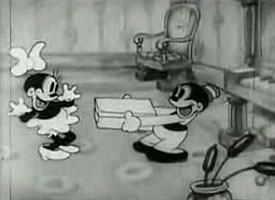 In Bosko's Party (1932) we first see him walking down the street holding a package & carrying patched umbrella, whistling "Ain't Gonna Rain No More."
In Bosko's Party (1932) we first see him walking down the street holding a package & carrying patched umbrella, whistling "Ain't Gonna Rain No More."
Honey's at home making herself up for Bosko's visit. A pig answers the door when Bosko arrives, shushing him. There are animal-people hiding all over the house intending to surprise Honey for her birthday. In a later scene of group-celebration it looks like Mickey Mouse blowing a horn & Oswald the Lucky Rabbit waving a flag are among the gathering.
Honey's dog finds it confusing there are people hiding all over the place & barks at them. And since she's in fact home in her private boudoire, her dog's quite right that there's something on the unpleasant side about so many visitors sneaking around the house while she's not even fully dressed yet.
When Honey walks in the room, everyone leaps out & does ring-around-the-rosy with her in the middle. Bosko gives her the box with his present, but Honey's dog is in the box.
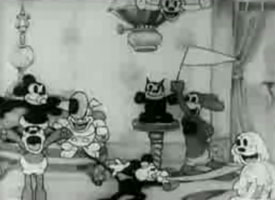 The dog leaps out & runs off & leaps to the bottom of an aquarium, where it can apparently breathe fine. It's apparently afraid of Bosko so won't come out of the aquarium. The dog leaps out & runs off & leaps to the bottom of an aquarium, where it can apparently breathe fine. It's apparently afraid of Bosko so won't come out of the aquarium.
Everybody sings Happy Birthday, while Bosko gets the dog out of the aquarium, then returns to his gift box & gives Honey a ukelele. Although we see her playing it wildly, & both she & Bosko are visually singing, all we hear is the continous soundtrack's tune & the dog barking.
The partiers are really enjoying the song, but when we are again shown the couple singing, we hear only the crowd's cheers. The third time they're shown, suddenly Honey's singing & strumming can be heard; the number is "Sugar" composed Maceo Pinkard & Sidney D. Mitchell.
An ongoing series of gags have involved Honey's kitten Wilber trapped under a flower pot, getting its tail caught in a mouse trap, falling through banister rails at the top of the staircase, & landing in Honey's birthday cake splashing cake everwhere, a burning candle landing on top of Bosko's head.
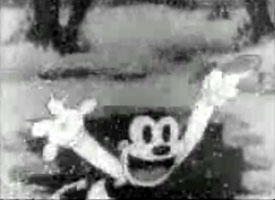 Sometimes Bosko seems very adult, other times he's more clearly a little boy, as in Big Hearted Bosko; aka, Bosko's Orphans (1932). It's winter. Bosko is skating on a frozen lake, his big dog Bruno bounding along behind him. They're having great fun together. The dog barks in time with the musical soundtrack.
Sometimes Bosko seems very adult, other times he's more clearly a little boy, as in Big Hearted Bosko; aka, Bosko's Orphans (1932). It's winter. Bosko is skating on a frozen lake, his big dog Bruno bounding along behind him. They're having great fun together. The dog barks in time with the musical soundtrack.
After a couple near misses, the dog finally slides into a hole in the pond. He howls with misery, & Bosko rushes to the hole. Bruno has sunk into the water & Bosko, weeping, cries out in woefulness. But Bruno's safe in a hollow log, & leaps out with a "Yoo hoo!"
Throughout the extensive skating adventures, the amount of footage that is just repeating, then reversed to repeat again, means about forty-five seconds worth of drawings were stretchable to three minutes. The common budget-saving method was taken a mite too far in this one.
Bruno rescues an abandoned baby. Bosko says of the wailing infant, "Let's take him home!" At home in a rocking cradle Bosko just happened to have around, Bruno rocks the cranky kid while Bosko plays his violin.
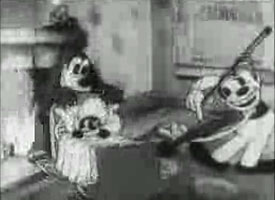 The baby squawls no matter what. Bruno's first to not like it anymore. It stops wailing momentarily when Bosko plays a flute & Bruno marches around with a drum, but soon it's pure noise again. It's becoming clear why the kid was abandoned out in the cold! The baby squawls no matter what. Bruno's first to not like it anymore. It stops wailing momentarily when Bosko plays a flute & Bruno marches around with a drum, but soon it's pure noise again. It's becoming clear why the kid was abandoned out in the cold!
Each time Bruno tries to get away from the baby's squawling, fleeing to anywhere else in the room or house, bad things happen to him, catching his butt on fire accidentally sitting on the stove, next having a cookoo clock fall on him.
Bosko plays piano & makes shadow figures with his hands & does some scat-jazz, trying to keep the kid entertained. Bruno wears a lampshade for a skirt & dances about. Two goldfish in a bowl are also dancing.
While Bosko & Bruno dance about wildly, the baby has finally grown quiet, but they accidentally knock the goldfish off the stand & it lands over Bosko's head like a diving helmet.
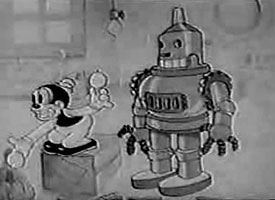 Honey is busy spring cleaning. Bosko arrives with Bruno, though Bruno will be left outside & not seen again until near the end of the episode.
Honey is busy spring cleaning. Bosko arrives with Bruno, though Bruno will be left outside & not seen again until near the end of the episode.
Bosko picks Honey's flowers from a planter to give her as a bouquet, having a streak of scoundrel in him from time to time. She lets him in very happy to see him.
Alas for Bosko, the reason she's so thrilled to see him is because he can help her with the dishes, which annoys him no end. He asserts that he won't do dishes, no way, but in the next scene he's drying dishes with a scowl as Honey sings "Ain't We Got Fun."
For some reason Honey has about fifty plates, which Bosko shuffles together like decks of card, then trips down a staircase breaking the whole huge set. Feeling sheepish under Honey's glower, he actually turns into a sheep for a couple seconds.
He spots a newspaper headline "Robot will do work of hundred men, say technocrazy," & immediately decides to build hlis own robot, which will be ever so much easier than doing the dishes. He runs into the garage & starts with a pair of clothing irons for feet, two stovepipes for leg, a potbellied stove for torso, & soon he has a big chunky metal man.
Honey calls from her window, "Bosko! You come help me!" Putting the last touches on the robot (blinking lightbulbs for eyes) he cranks him up from behind. The robot takes off like a holy terror making shotgun sounds. Bosko tries to shut the door against him, but the robot bursts right through the door & rampages around Honey's house.
Bold Honey sprays him with perfume & says, "Oh, swish!" & becomes a gay robot for a while. But then he gets butch again & threatens Bosko anew, clever Honey winds up a record player with "Mary Had a Little Lamb" on it, & shoves it in the mechanical man's butt-flap.
The robot prances about smiling & singing the kid's song, until the record gets stuck. Honey & Bosko run out of the house leaping over Bruno who was sleeping on the stoop. The robot electrocutes the poor dog, who takes off in terror. Bosko blows up the robot, which springs all its springs including a cookoo bird.
Very imaginative, even allowing for the fact that robots were a commonplace in other early cartoons, i.e., Oswald Rabbit's The Mechanical Man (1932), Mickey's Mechanical Man (1933), or Bimbo's The Robot (1932).
copyright © by Paghat the Ratgirl
|
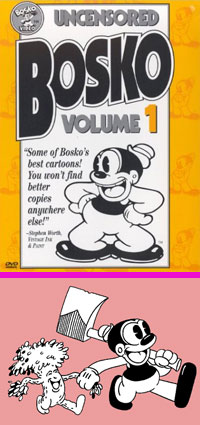



 One of the shrubs gives him the rasberry which for some reason makes Bosko mad. He chases after the shrub or baby tree that has turned its roots into feet.
One of the shrubs gives him the rasberry which for some reason makes Bosko mad. He chases after the shrub or baby tree that has turned its roots into feet.

 Bosko next encounters two baby monkeys playing leapfrog. Bosko speaks his first piece of dialogue: "Hello!" as he picks up one of the baby monkeys, which scowls without appreciation for being grabbed.
Bosko next encounters two baby monkeys playing leapfrog. Bosko speaks his first piece of dialogue: "Hello!" as he picks up one of the baby monkeys, which scowls without appreciation for being grabbed.
 The gags are random & we get even less of a story than usual, not that plots were ever significant in Bosko films.
The gags are random & we get even less of a story than usual, not that plots were ever significant in Bosko films.
 He plays his banjo as the car drives along the road. A mouse is pretending to be the hood ornament. When Bosko needs a new string for his banjo, he clips off the mouse's tail. The angry mouse is able to pull his tail to stretch it to its former length, but when Bosko breaks another banjo string, the mouse gives him the raspberry & abandons his position on the hood.
He plays his banjo as the car drives along the road. A mouse is pretending to be the hood ornament. When Bosko needs a new string for his banjo, he clips off the mouse's tail. The angry mouse is able to pull his tail to stretch it to its former length, but when Bosko breaks another banjo string, the mouse gives him the raspberry & abandons his position on the hood.
 The dog leaps out & runs off & leaps to the bottom of an aquarium, where it can apparently breathe fine. It's apparently afraid of Bosko so won't come out of the aquarium.
The dog leaps out & runs off & leaps to the bottom of an aquarium, where it can apparently breathe fine. It's apparently afraid of Bosko so won't come out of the aquarium.
 The baby squawls no matter what. Bruno's first to not like it anymore. It stops wailing momentarily when Bosko plays a flute & Bruno marches around with a drum, but soon it's pure noise again. It's becoming clear why the kid was abandoned out in the cold!
The baby squawls no matter what. Bruno's first to not like it anymore. It stops wailing momentarily when Bosko plays a flute & Bruno marches around with a drum, but soon it's pure noise again. It's becoming clear why the kid was abandoned out in the cold!